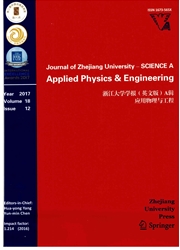

 中文摘要:
中文摘要:
研究目的:基于声源识别,得出车外噪声分布特性及场点主要噪声源。创新要点:1.研究高速列车噪声源强特性及频谱特性;2.揭示不同速度下不同声源频谱变化规律;3.分析车外声场场点噪声变化规律及主要声源。研究方法:1.利用车外声源识别系统(图2)分析高速列车声源分布规律及频谱特性;2.利用声源的垂向(图10)分布研究不同声源在各频率下垂向分布规律;3.利用场点声源与速度的拟合关系(图16)研究场点主要噪声源。重要结论:1.高速列车车外噪声源主要分布在轮轨区域、受电弓和车间连接区域;2.轮轨区域噪声包括滚动噪声和气动噪声,在各频率均为最显著声源;3.在整个列车高度,轮轨滚动噪声对总噪声贡献率大于气动噪声;4.车外场点噪声主要频率为630-2500Hz,主要来自轮轨滚动噪声。
 英文摘要:
英文摘要:
This paper presents a detailed discussion of the experimental analysis of the external noise produced by a Chinese high-speed train traveling at different speeds. Based on the delay and sum beam-forming method, a microphone array with 78 microphones was used to measure the external noise produced by the train moving at speeds of up to 390 km/h. The experiment and its analysis showed that the main noise produced by the train originates in three areas: the wheel/rail system (or bogies), the pantograph, and the inter-coach gaps of the train. The frequency characteristics and sound exposure level (SEL) of these main sources were analyzed for different speeds. In the range of 5000 Hz, the SELs of the three main noise sources are clearly identified. Along the vertical height of the train, as seen from the rail head, the maximum noise levels always occur in the wheel/rail area. At different measurement field points, the predominant noise components of the total noise have different frequencies that vary with the train speed. Furthermore, at the measurement points, the rolling noise has a greater contribution to the total noise than the aerodynamic noise. The experimental results and their corresponding analysis are very useful for the control and reduction of the external noise produced by high-speed trains.
 同期刊论文项目
同期刊论文项目
 同项目期刊论文
同项目期刊论文
 期刊信息
期刊信息
